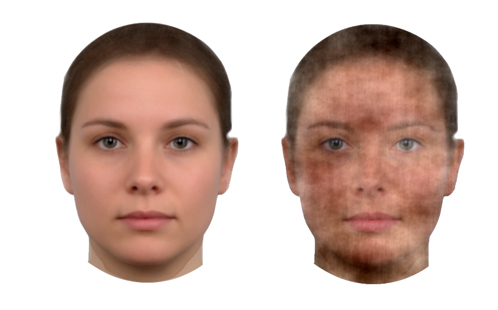Study finds obscured strangers appear older and more masculine

The more "noise" on an unfamiliar face, the older and more masculine they appear
When you encounter a stranger, it's important to make a sensible assessment of who that person might be. A new study (opens in a new window) from Western Sydney University and the UNSW suggests that when in doubt, such as when seeing someone through fog or for only a fleeting glimpse, you'll think the person is more masculine and older than they really are.
Not only that, it also seems you reach this conclusion because you actually see the person that way, raising questions about the accuracy of eyewitness accounts and the ability of people like bouncers to accurately guess people's age.
"Correctly judging the age and sex of the people we meet is important in any number of social interactions," says lead author Dr Tamara Watson of Western Sydney University.
"Despite this, even when we can clearly see a face, we often don't get the answer right. We tend to rate faces as more masculine and closer to our own age than they really are."
"Overcoming this kind of bias is important in a growing number of situations where we need to reach the right answer about the identity of unfamiliar people."
In the study, published in the Journal of Vision, the researchers asked people to rate a series of faces that were progressively more difficult to clearly discern.
"By making faces harder to see, we are forcing the brain to 'fill in the gaps' with inbuilt perceptual knowledge, allowing us to measure what type of face the brain fills the gaps with. In other words, how you actually see the face," says Dr Watson.
"It turns out that when you have less information, the brain fills in the gaps with a very masculine appearance."
When it comes to estimating age, the story gets more complicated.
"The human brain naturally makes an inference that faces are closer to our own age than they really are,," she says.
"What our study found is that obscured faces are perceived to be older as well.
"We think this automatic tendency to see a person as more masculine and older might be a good thing when a stranger is approaching through the fog. Without any delay, we're effectively seeing the stranger as a more dominant person. You'd probably approach them more cautiously and that's likely to be a good thing"
But Dr Watson says it's not so useful in a situation where the accuracy of our decision is crucial.
"Consider situations when we are asked to give eye witness accounts of a crime, or when a bouncer judges the age of a person entering a nightclub," she says.
"In these cases, it seems that just asking the person to think harder won't create a better decision, as we have a tendency to replace uncertain information with biased assumptions."
"Now we have an idea of how these biases come about, we can work on the best strategies for becoming more accurate."
The study "Who are you expecting? Biases in face perception reveal prior expectations for sex and age" by Tamara Watson, Yumiko Otsuka and Colin W.G. Clifford has been published in the latest issue of Journal of Vision (opens in a new window).
This research is funded by the Australian Research Council.
Ends
19 February 2016
Latest News

Opinion: What do we lose when our old suburbs disappear?
I live on the edge of Parramatta, Australia’s fastest-growing city.

Opinion: Most bees don’t die after stinging – and other surprising bee facts
Most of us have been stung by a bee and we know it’s not much fun. But maybe we also felt a tinge of regret, or vindication, knowing the offending bee will die. Right? Well, for 99.96% of bee species, that’s not actually the case.

Western Sydney University receives transformational donation to support LGBTIQA+ community
Western Sydney University has welcomed a philanthropic donation from The Brennan Lynch Foundation.
Mobile options:

